Fans of super-sized fruit, brace yourselves. The largest tomato ever grown was such an epic size it weighed as much as a bowling ball! Read on to discover everything about this behemoth tomato and how to grow whopper-sized gems in your backyard.
Official Largest Tomato Ever Grown
The heaviest tomato ever grown weighed an astronomical 11.65 lbs (5.284 kilograms).
Del and Julie Faust from the United States grew the super-sized tomato from a 9.06 Brown seed. It was confirmed the world’s largest by officials at the Stilwater Harvest Festival, Minnesota, on October 8, 2022. Representatives from the Great Pumpkin Commonwealth ensured everything was above board.
You can view the record-breaking couple with their prize winner here.
As well as its epic weight, the record-breaking tomato’s total circumference was gigantic at 32.5 inches (82.55 cm). It wasn’t the prettiest tomato ever seen. In fact, it looked like an alien being and totally unappetizing, but looks don’t matter when it comes to record breakers.
The new world record tomato beat Dan Sutherland’s previous record of 10.8 lbs (4.896 kilograms) by a fair margin.
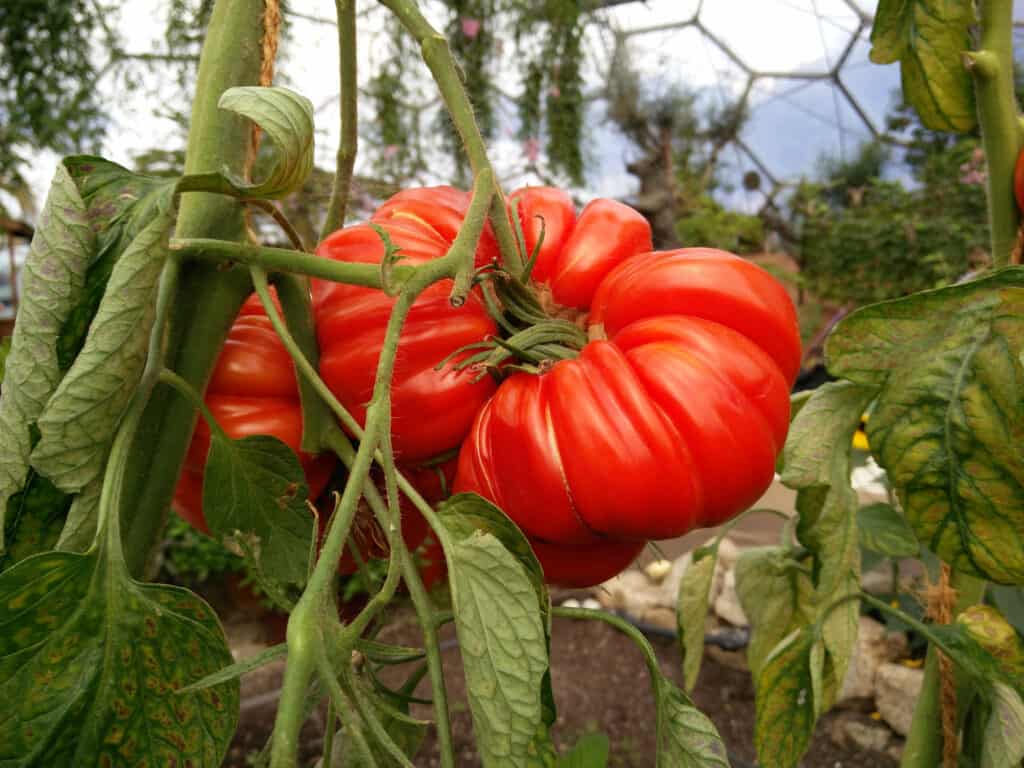
The world’s heaviest tomato was a beefsteak variety like this, but it measured 10 inches in diameter.
©iStock.com/Sophie Shoults
Is It Really the Largest Ever?
The 11.65 lb tomato is officially the heaviest tomato ever grown, but previous record holder Dan Sutherland produced a larger specimen on social media in 2022 that weighed 16.85 lbs (7.64 kilograms).
However, because it was not officially weighed or assessed in a ratified competition, he can’t claim the record. Del and Julie Faust’s officially weighed tomato holds the title.
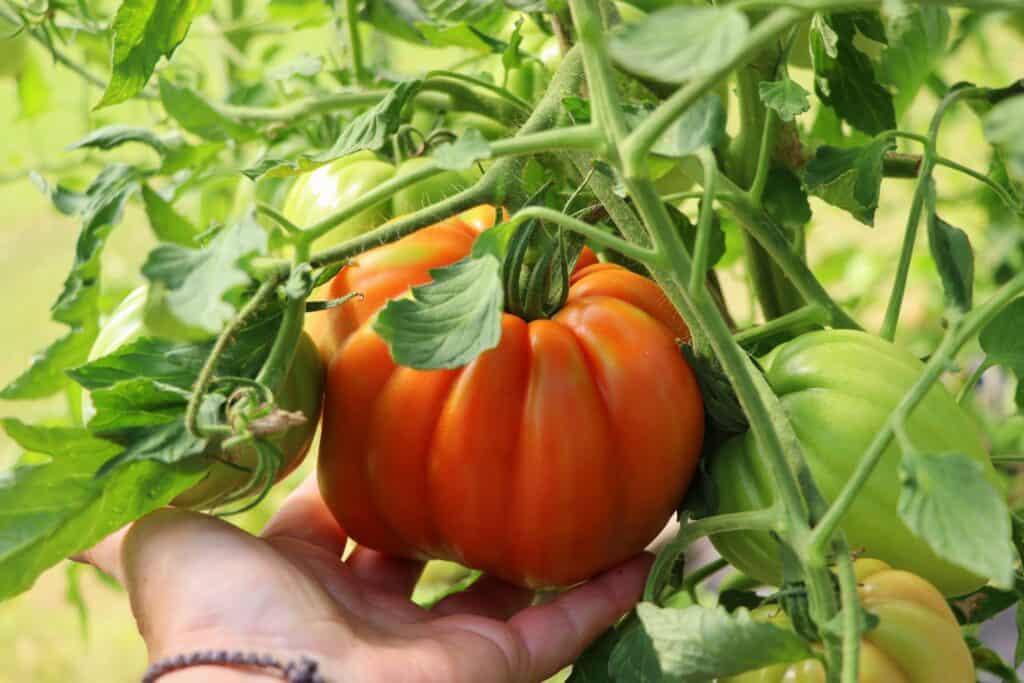
World record-breaking tomatoes must be officially weighed to claim a title.
©vaivirga/Shutterstock.com
Is Tomato A Fruit or Vegetable?
Technically, a tomato is both.
Botanically speaking, tomatoes have flowers and contain seeds, so they’re a fruit, but because they’re used like a vegetable, they’re considered a vegetable by chefs. In 1893, the U.S. Supreme Court ruled tomatoes should be legally classified as vegetables.
Tom-may-toe or tom-arr-toe, fruit or veg, it doesn’t change the taste of their delicious flavor and health-giving nutrients. According to the University of Michigan, one tomato serving contains vitamins A, B, C, K, potassium, beta-carotene, and fiber. Potential health benefits include healthy skin, strong bones, stable blood sugar, improved vision, and protection against gallstones and heart disease.

Tomatoes are packed with vitamins, minerals, and fiber.
©Digihelion/Shutterstock.com
Where Are Tomatoes Originally From?
Today, tomatoes grow across the globe, but they originally came from the lower Andes. Mexican Aztecs cultivated what they called tomatl, which meant plump fruit. When the Spanish conquered the Aztec lands, they called it tomate and took seeds back to Spain, probably in the early 16th century with Columbus. From there, tomatoes spread across Europe, and the first settlers took them to North America.
Other World Record-Breaking Fruit
The competitive world of superfruit and veg is a tough place, and prize-winning tomatoes are lusted after. Titles regularly change hands, but here’s a selection of the current heaviest fruit and veg in the world.
Most Tomatoes on a Single Stem
The Guinness World Record for most tomatoes on a single stem is held by British grower Douglas Smith. His cherry tomato plant grew an unbelievable 1,269 cherry tomatoes on a single stem. Smith also holds the title for the U.K.’s heaviest tomato at 6.85 lbs (3.1 kilograms). The man really does love his tomatoes.

The record for most tomatoes on a single stem stands at 1,269, many more than the stems in this photo.
©Graham Corney/Shutterstock.com
Heaviest Cucumber
The U.K.’s David Thomas holds the Guinness World Record for the heaviest cucumber. His whopping cucumber was weighed at the Malvern Autumn Show in Worcestershire, U.K., on September 26, 2015. It topped the scales at 23 lbs 7 ozs (12.9 kilograms). That’s about the weight of 30 full beer cans.
Heaviest Chili Pepper
The world’s heaviest chili pepper weighed 460 grams, that’s heavier than a can of Coke. Paul Davies of the U.K. grew it in Halesowen and was officially weighed on September 7, 2020.
Heaviest Apple
Chisato Iwasaki of Japan’s Hiroaki City grew the world’s heaviest apple in October 2005 on his apple farm. It weighed an epic 4 lbs 1 oz (1.849 kilograms).
Heaviest Eggplant
The U.K.’s Peter Glazebrook grew the world’s heaviest eggplant (called an aubergine in the U.K.) in September 2022. It weighed 6 lbs 14 ozs and was confirmed by the National Vegetable Society.
Glazebrook is a veteran of competitive giant vegetable growing. He’s gained 17 titles to date, including the world’s heaviest potato in 2011. His massive spud broke the world record at 10 lbs 15 ozs (4.98 kilograms).
How to Grow Big Tomatoes
Growing an epically huge tomato starts with seed selection. Some of the biggest available are meaty flavored beefsteak tomatoes. The Fausts used a 9.06 Brown seed, but they’re difficult to find. Other large cultivars include:
- Gigantimo
- Behemoth
- Giant Tree
- Dinner Plate
- Mortgage Lifter
- Believe it or Not
- Goliath
- Oxheart
Once the seeds have arrived, it’s time to start planting. Tomatoes need sun and warmth, so most growers start them off early in a glasshouse, polytunnel, or on a sunny windowsill. Getting an early start means the tomatoes have more time to grow before fall arrives.
Here are some top tips to help you grow large tomatoes that’ll give Del and Julie Faust a run for their money!
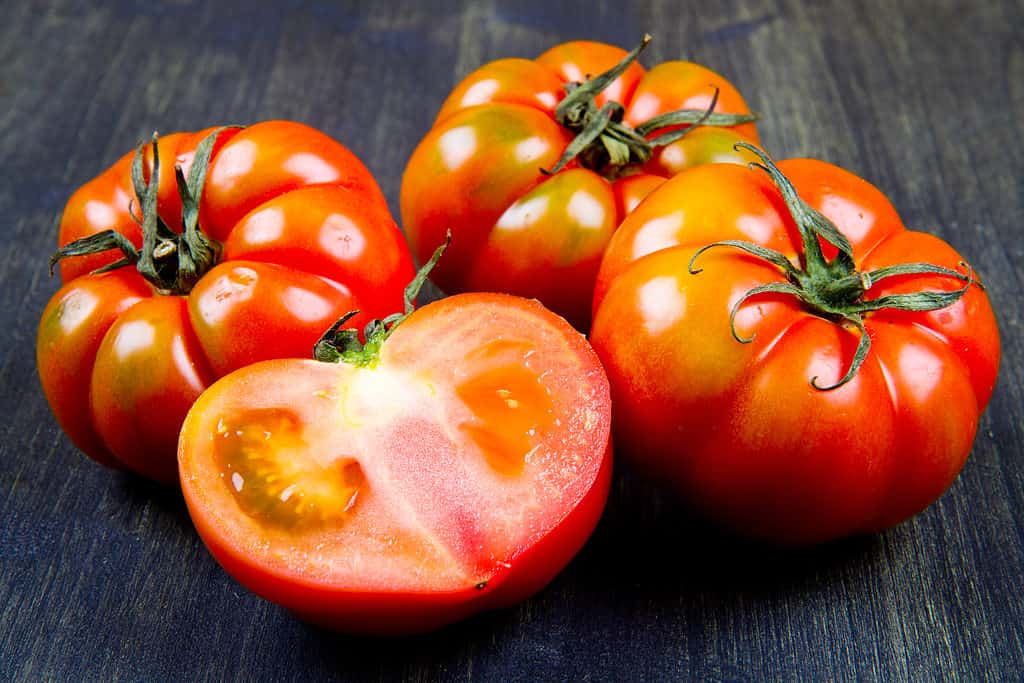
Beefsteak tomatoes are the largest tomato cultivars.
©Luca Santilli/Shutterstock.com
Best Soil for Giant Tomatoes
If you want to grow the world’s heaviest tomato (or perhaps just larger ones for your dinner table), then nutrient-rich soil is important. Tomato-ready grow bags are a good starting point, but if you’re growing tomatoes in the soil, be sure to beef it up with well-rotted organic matter before planting out.
Tomatoes Prefer Full Sun
Tomatoes worship the sun. They’re native to hot South America, so the more sunshine they absorb, the bigger and sweeter the fruits. At least eight hours a day is required. In cooler areas, tomatoes grow best under glass, which protects them from cold winds and magnifies the sun’s rays.
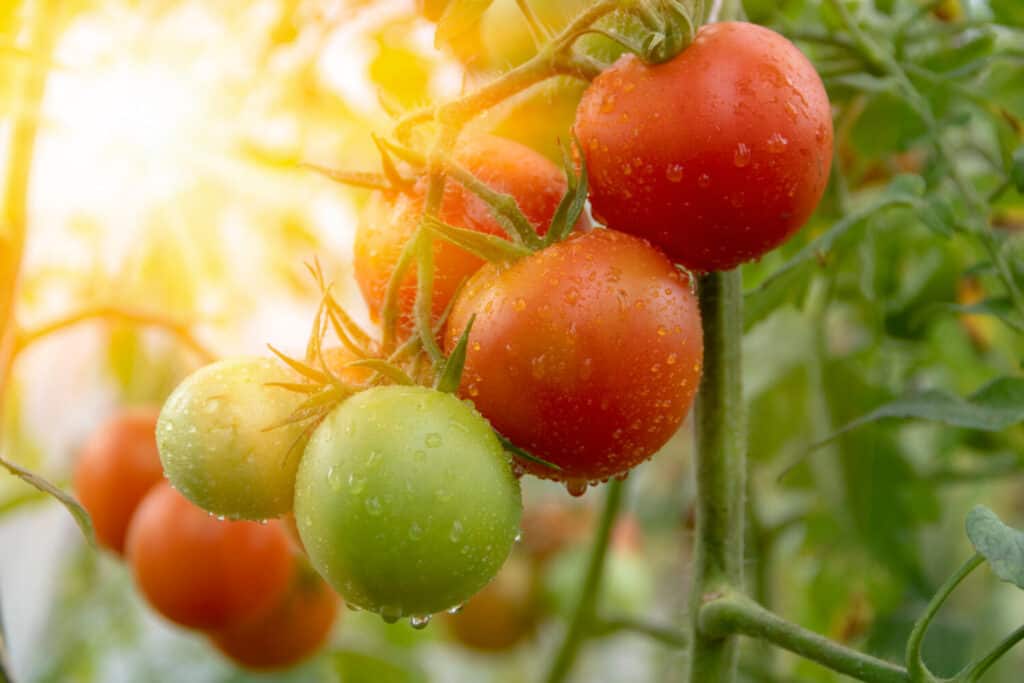
Tomatoes need at least eight hours of sun every day.
©Valery Rybakow/Shutterstock.com
Space Them Out
Crowded tomato plants compete for water, nutrients, and sunlight, plus the lack of air circulation breeds mold and mildew.
Space cordon tomatoes at least two feet apart. They always grow larger than you remember.
Plant Out Deeply
Gardeners are usually told to plant at the same height as a nursery pot, but this is not the case with small or large tomatoes.
A tomato puts out roots on its main stem to stabilize itself from winds and weighty fruit. Bury tomato plants up to their first set of leaves. Don’t worry, they won’t rot, and it’ll help them suck up all the nutrients they need to grow whopping-sized fruits.
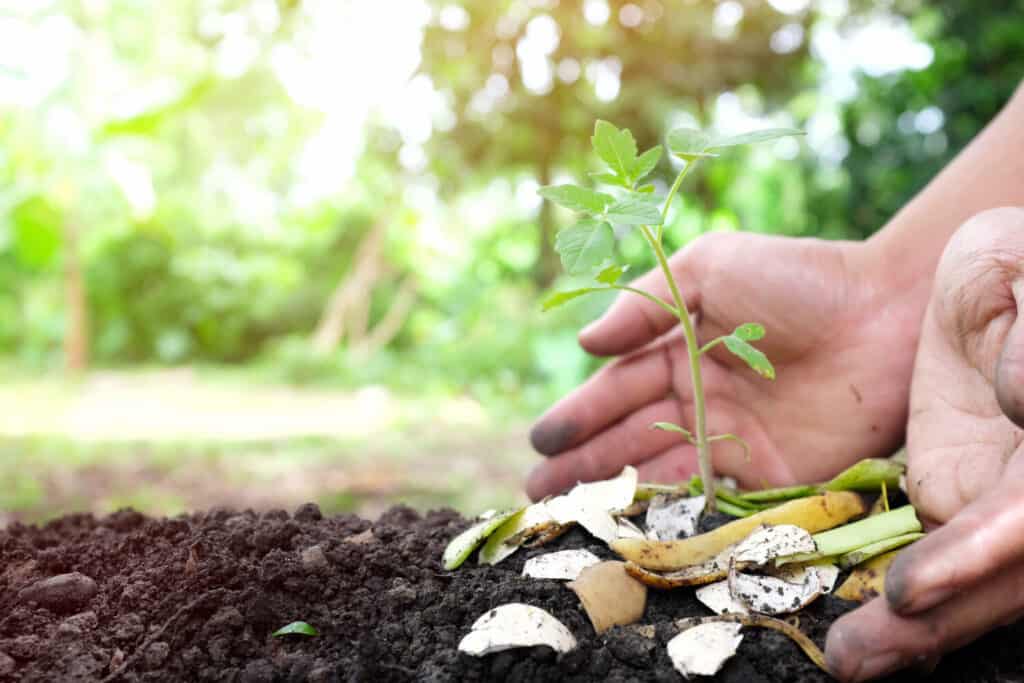
Bury tomato plants to at least the first set of leaves to help stabilize the main stem.
©sulit.photos/Shutterstock.com
Water Them Every Day
How much water tomatoes need depends on your growing zone, but the trick is to make sure they don’t dry out. Dry soil leads to skin splits and fallen flowers.
Feed Regularly
Once a tomato plant has set its flowers, it’s time to fertilize it once a week. Use a balanced fertilizer such as seaweed or commercial tomato feed and avoid splashing the foliage.
Without fertilizer, it’s unlikely your tomatoes will grow large. If foliage turns yellow, that usually means they need more fertilizer.
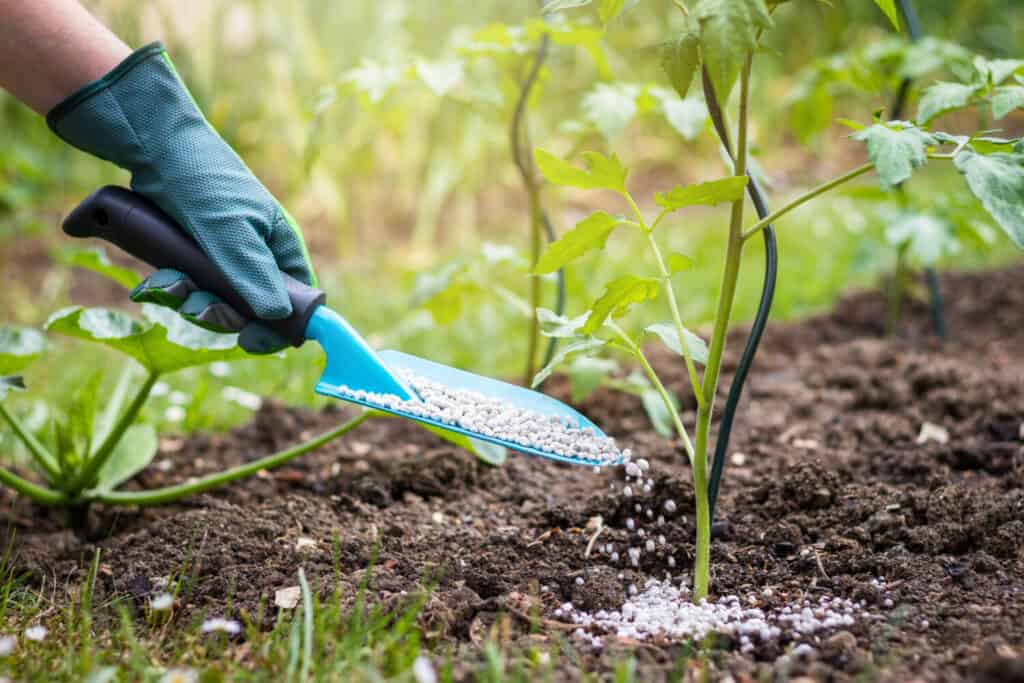
Fertilize tomatoes when the first flowers appear.
©encierro/Shutterstock.com
Mulch
Add organic mulch to your tomato plant’s roots because it discourages weeds, traps moisture, and provides nutrients.
Provide Support
Unless it’s a cherry tomato that supports its own weight, tomatoes need a stake, cage, or trellis to keep their fruit off the ground. Massive tomatoes benefit from hammock supports that keep them attached to the vine longer.
Defend From Pests
Aphids and caterpillars may invade, so keep an eye out for these pests and get rid of them quickly. Growing pot marigolds and basil nearby is a good way to deter pests naturally. You can also use dish soap and water or a citrus-soaked water spray to keep creatures at bay if pesticides aren’t your thing.
Deer, squirrels, groundhogs, and rabbits might also prove troublesome!
Concentrate on One Prize Tomato
If it’s one epically huge tomato you’re after, pinch off smaller tomatoes and encourage just one to develop. Leaving just one on the vine means it gets to absorb all the nutrients. Pinch off flowers as they appear, and prepare a pantyhose hammock!
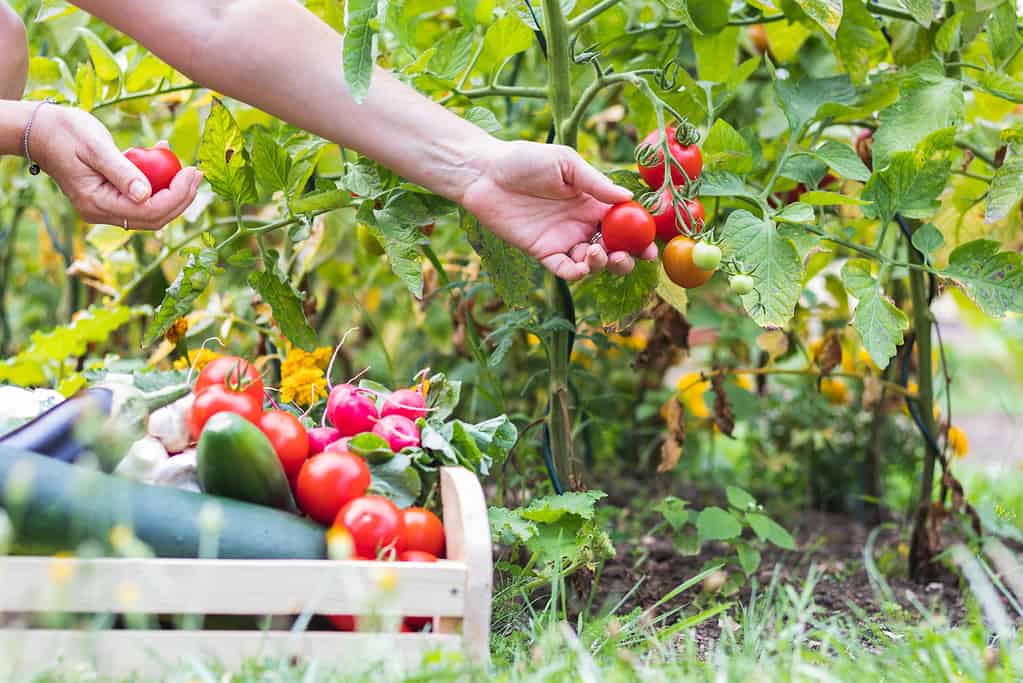
Remove all but one tomato to increase the chances of growing a bowling ball-sized fruit.
©iStock.com/Zbynek Pospisil
The photo featured at the top of this post is © iStock.com/Sophie Shoults
Thank you for reading! Have some feedback for us? Contact the AZ Animals editorial team.







